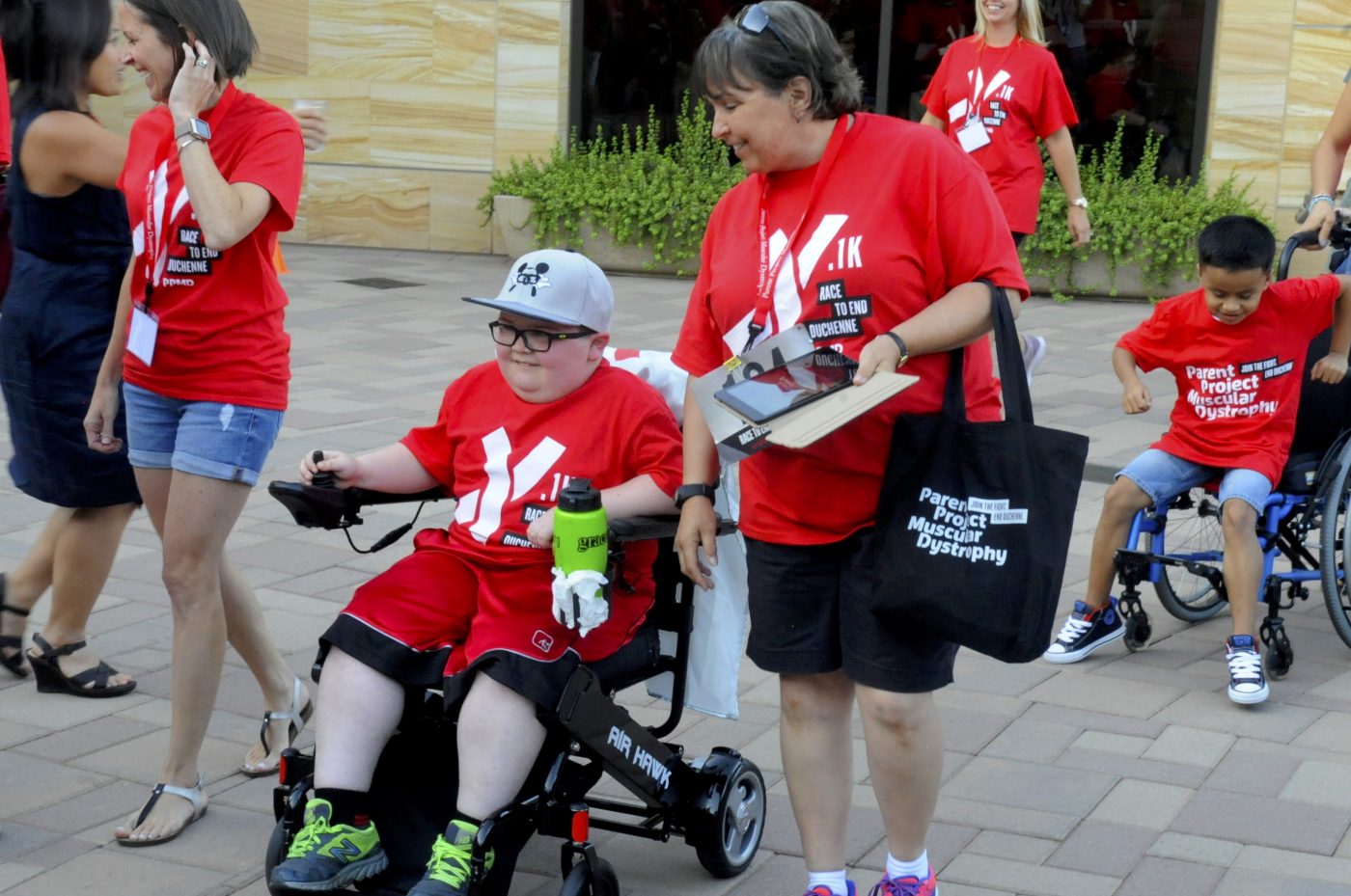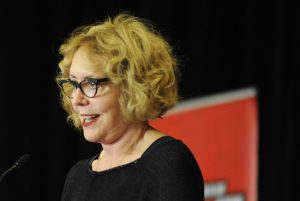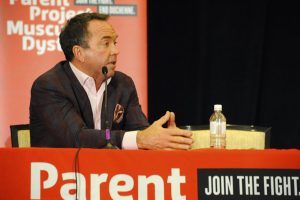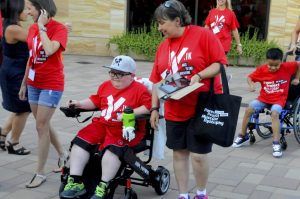#PPMD2018 – Duchenne Research ‘Has Come a Long Way,’ PPMD Says at Meeting

Duchenne boys compete in the .1K Race during the PPMD meet in Phoenix. (Photo by Larry Luxner)
Never before has the therapeutic pipeline of potential treatments for Duchenne muscular dystrophy appeared so promising. Yet that also means more questions than ever.
Searching for answers, about 620 people — 70 percent of them parents — converged on Phoenix, Arizona, in late June for the 2018 Annual Conference organized by Parent Project Muscular Dystrophy (PPMD).
“It requires a village to care for Duchenne, a lifetime of care across the spectrum,” said Pat Furlong, PPMD’s founding president and CEO, who lost two sons to the disease. “It’s phenomenal where we are, but we need to get there faster. We’d like less exposure to placebos, and faster trials, and trials that combine therapies.”
Furlong added that “we’ve come a long way” since the first Duchenne center of excellence opened in 1994 at the University of Pittsburgh.
“When my sons were here, there was no pipeline, no standards of care,” she said. “Thirty years ago, we were just dreaming about it, but here we are now.”
Meeting covers wide range of topics
The June 28-30 event, held at The Phoenician Resort in suburban Scottsdale, focused on the latest medical research involving restoring or replacing dystrophin, the protein lacking in Duchenne patients. But it also featured a 100-meter wheelchair race for boys with Duchenne, a discussion of often-overlooked dental and digestive problems associated with the disease, and a workshop for brothers and sisters of Duchenne patients.
“Siblings feel responsible for protecting and defending the affected child, but they may also receive teasing,” said Eric M. Butter, PhD. “They may have difficulty expressing their own needs because they may feel they are not as important.
“Let them know they’re important as well. There should be equality among siblings,” he said.
Butter also talked about the strains Duchenne can put on a marriage.
“Divorce is common for everyone. But when you’re dealing with a complicated disease like Duchenne, those strains increase the risk for divorce, so be a dynamic duo,” Butter advised. “Do your best to stay healthy in your relationship. You might be out of sync with each other. The disease can divide you. Know this. Expect this. It’s extreme stress. Be real with each other.”
He added: “If divorce comes, let it come. But don’t let Duchenne be the reason.”
Good and bad news at PPMD 2018
Twelve major pharmaceutical companies co-sponsored the PPMD 2018 conference, including PTC Therapeutics, Santhera Pharmaceuticals, Sarepta Therapeutics, Pfizer, Solid Biosciences, Summit and Mallinckrodt.
“We’re going to attack this disease every way we can find,” said Douglas S. Ingram, president and CEO of Sarepta, whose FDA-approved exon-skipping therapy, Exondys 51 (eteplirsen), costs between $750,000 to $1.5 million a year.
“We want to develop life-changing medicine to treat 100 percent of individuals with Duchenne muscular dystrophy, and we’ve done a lot over the last 12 months to fulfill that goal,” he said.
Ingram said Sarepta has 21 ongoing development programs, 16 of which “focus on bringing a better life to those living with Duchenne.”
The company has also developed a gene therapy “center of excellence” in Columbus, Ohio; expanded its lab space considerably; and lured several experts to its team, including Louise Rodino-Klapac, PhD, vice president of gene therapy, and Gilmore O’Neill, MB, chief medical officer.
But not all the news has been positive.
During the conference, Summit announced it had ended development of ezutromid as a treatment for Duchenne after a Phase 2 clinical trial testing the therapy failed to reach both its primary and secondary objectives.
“To say we were shocked would be an understatement,” Michelle Avery, Summit’s director of patient engagement, told parents at the PPMD conference as she apologized for her company’s “incredibly disappointing results” with ezutromid.
“It was not an easy decision to stop development of a drug, but PhaseOut DMD gave us a very clear answer: there was no benefit for patients taking this drug. There was no difference in the 6-minute walk test after 48 weeks of treatment,” she said.
“Could it slow the progression of Duchenne? We have definitely answered that it cannot,” Avery said. “We are eternally grateful to the families of PhaseOut DMD. To this end, we plan to explore how the information gathered as part of the trial could be made available. We believe there’s a lot of promising research on the horizon, and we have reason to have high hopes for the future of Duchenne research.”
Duchenne gets its own ICD-10 code
Also during the conference, Furlong announced that on Oct. 1, Duchenne and Becker muscular dystrophy will finally get their own ICD-10 disease code — G71.02 — after years of lobbying.
This is extremely important for everything from research to reimbursements, she said.
“Whenever you’re trying to get access to information or reimbursement for drugs, they look for an ICD-10 code. In the past, we were lumped together with other muscular dystrophies, so we couldn’t really access data or make sure they were accurate,” Furlong said. “Now with the ICD-10 code, it’s Duchenne-specific, so we’ll be able to look at any health records.”
The International Classification of Disease (ICD) is the standard for reporting diseases and health conditions. On the same day, Angelman syndrome will also get its own code, Q93.51. This is crucial not only for research into this disease, but for even understanding how many people have it.
Furlong said PPMD has worked closely with the Centers for Disease Control & Prevention’s National Center for Birth Defects and Disabilities, as well as the Centers for Medicare & Medicaid Services to establish the separate code for Duchenne and Becker MD.
“The lack of an ICD code specific to Duchenne/Becker and FSH muscular dystrophy has proven a barrier to diagnosis, care, surveillance, research and access,” she said in a December 2017 press release announcing approval of the code.
“While we have established surveillance through the passage of the MD-CARE Act, we have also had to develop costly and time-consuming processes to discern Duchenne, Becker and FSH muscular dystrophy cases from those abstracted using previous ICD codes,” she said. “With approved therapies, payer decisions are now being impacted as over-estimates of economic impacts are made when applying the calculations to their datasets.”
On Capitol Hill, PPMD has certainly made its voice heard, said Annie Kennedy, the organization’s senior vice-president of legislation and public policy.
“In the late ‘90s, we had a very barren landscape in Washington; there wasn’t a lot happening,” Kennedy said. “Today, the Duchenne community is one of the most empowered, well-known patient communities in Washington, but it took a lot of work to get there.
“Since 1994, PPMD has played a role at every single victory in the fight to end Duchenne,” she said. “We are the definition of a patient-powered community. That’s because we began to convene and bring partners to the table — one connection, one congressional member at a time.”









